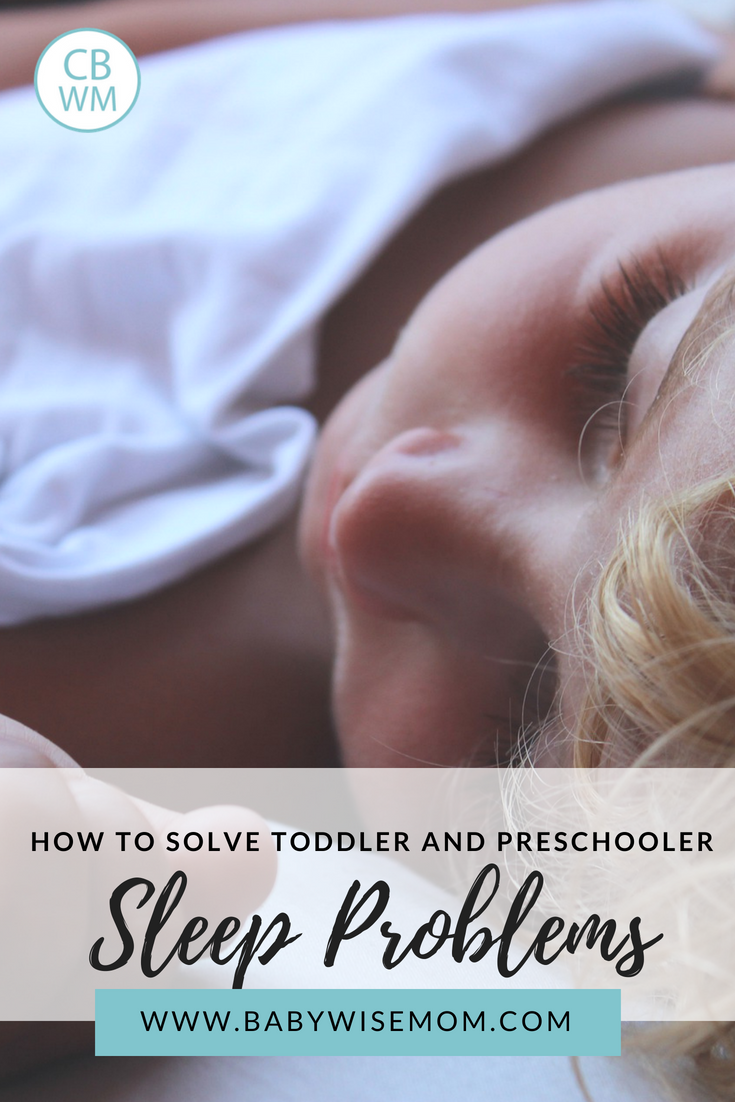How to Solve Sleep Problems for Toddlers and Preschoolers. Two simple ways to get your child taking great naps.

Almost every Monday, I do a live video on Facebook answering questions from readers. Almost every single week, I get questions about troubles with sleep, usually naps, for older babies, young toddlers, and preschoolers. I have on common set of questions for these parents.
How is the child’s exercise? How is the child’s mental stimulation?
If your child was sleeping well and suddenly stops sleeping well, there can be a variety of reasons for the sleep problems. There are many reasons for poor sleep. It could be a common sleep disruption all children face. You might need waketime length adjusted or it might be time for a nap to be dropped.
By the time you have an older baby, toddler, or preschooler, you are quiet accustomed to considering all of these factors. When your toddler or preschooler does not sleep well, you know what to look for. You know to watch for waketime length, nap length, and teething signs. But do you consider exercise and stimulation?
No?
Add it to your list. Consider it from here on out.
Here is why.
Post Contents
The Importance of Exercise for Sleep
You will find sleep negatively impacted during the coldest of months when you hunker down inside to hide from the bitter cold outdoors. You will find sleep problems popping up after a few rainy days when you have been stuck indoors. You will notice your child isn’t napping as well even on hot days when you stay inside the air-conditioned house.
On these days, your child is not getting enough exercise. In Healthy Sleep Habits, Happy Child (affiliate link), Weissbluth states that if your baby is not sleeping well, you need to evaluate physical activity. Work to get enough physical activity into your child’s day so he will be tired at nap time and bedtime. You can get this done even when the weather is not perfect. Here are some ideas (affiliate links below):
- Go outside anyway. Dress for the weather and try to get some outside time in each day.
- Play inside. Get a mini trampoline. Get a ball pit. Search for gross motor activities you can do indoors. Turn some music on and dance to it. Do front roll-overs. Do jumping jacks. Run in place. Set up an obstacle course.
- Get out of the house. Go to an indoor play place. Go to an indoor trampoline play place. Go to an indoor gym where your child can run around and get exercise.
- Sign up for organized sports. Once your child is old enough, sign up for indoor physical activities. Dance class or gymnastics can be great. Karate is fun. Swimming lessons take a lot of physical effort. Find something indoor that your child can do to get that extra exercise in.
The Importance of Mental Stimulation for Sleep
Just as exercise helps make the body need sleep, mental stimulation helps make the brain need sleep. When you sleep, your brain processes what it learned that day. When your child was first born, basic life was enough mental stimulation for sleep. As your baby got older and could see further and take in the surroundings more, your baby still got enough stimulation from simply living life.

Now that your child is older, living life isn’t enough mental stimulation. Your child knows basic things like what a dog barking sounds like and what that means by now. Up to this point, you have been guarding your child’s stimulation levels to ensure she didn’t get over stimulated. Now you need to be sure she is stimulated enough. You don’t want her understimulated. Here are some ways to be sure your child’s brain gets enough stimulation:
- Limit screen time. Time in front of a television is passive time. You want your child’s brain in active learning.
- Encourage playtime. Having time to play each day with toys and use imagination is a great workout for your child’s brain. This is a major plug for Independent Playtime. Children learn through play, so simple playtime works out the brain.
- Go for walks. A walk opens up your child’s world. The house is full of things she sees every day, but on a walk, there is much to explore. Talk about the things you see to get even more learning in there.
- Have daily learning time. These do not need to be elaborate or fancy. As you are starting out, it can be as simple as having a shape of the day. Show your child the shape, then find it all around the house. For example, if your shape is rectangle, you might find that in doors, windows, and cabinets. Pinterest and the internet are both full of activities. If you want your activities planned for you, check out my eBook Babes, Tots, and Kids.
Solving the Sleep Problem
If your child stops sleeping well, consider your common disruptions, regressions, and schedule changes, but also consider these lesser-known, but no less impactful, issues of exercise and stimulation. Add in some physical movement. Add in some mental stimulation through interactive learning. These are simple to add in and do not require a major schedule change.
For more help, see What To Do When Toddler Cries at Nap Time
Sleep Problems and Strong-Willed Children
Parenting the Strong-Willed Child is a book on how to help children be obedient who are otherwise difficult to get to comply. The authors, Forehand and Long, include a short section on sleep for the Strong-Willed child.
Consistent Schedule
They point out that it is hard for a child to establish consistent wake and sleep cycles unless things are consistent with bedtime and waketime (page 229). They suggest you have a ritual of 10-20 minutes in the same order.
>>>Read: Importance of Consistent Bedtime
Daily Nap
They caution to not eliminate the nap prior to age four. It can be tempting to drop the nap earlier than this–especially if your child is resisting it. Keep the nap!
>>>Read: When Do Kids Stop Napping? And What To Do Instead
Sleep Training
They really encourage parents to teach children to sleep on their own early in life.
The authors say they have met with many teens and pre-teens who still need a parent to fall asleep (page 234). They say if you want a child to know how to sleep on his own, teach him early in life.
If your child comes out of bed, they suggest you take him back to bed without words and without anger. Once he is in bed, firmly tell him to stay there (page 232).
Handling Fear and Nightmares
Sometimes children get scared at night. Use imagination to your advantage.
Tell your child “It’s my job to keep monsters out of this house.” We have used that one before!
You can also create a monster repellent. They suggest an air freshner with a paper taped over it and an X on the front over a picture of a monster. Some parents use a squirt bottle with glitter inside–use your imagination!
>>>Read: Nightmares vs. Night Terrors: How To Help Your Child Through Each
Sleep is important for any child, and it is always important for good behavior–even for adults! Even adults are nicer when they have enough sleep.
These simple admonitions will help your child to sleep well: sleep on her own, have consistent bedtimes and waketimes, have nap for as long as your child NEEDS it not WANTS it, handle attempts to get out of sleep quickly and firmly, and address fear.
More Posts on Sleep Problems on this Blog:
- 2 Year Old Sleep Problems
- 10 Reasons Your 5-8 Month Old Has Stopped Sleeping Well
- Avoiding Sleep Problems
- Overstimulation
- Playing in the Crib/Bed
- Sleep Deficit
- Sleep Problems: Morning Wake-up Time is Too Early
- Season Changes Disrupting Sleep
- Sleep Needs and Difficulties for 7-12 Year Olds
- What to Do When Your Toddler Refuses to Take a Nap
- Common Reasons for Poor Sleep
- How Pacifiers Might Be Ruining Your Baby’s Sleep
- New Skills and Sleep Disruptions {Rolling, Crawling, Standing, etc.}
- Two Year Old Sleep Regression

